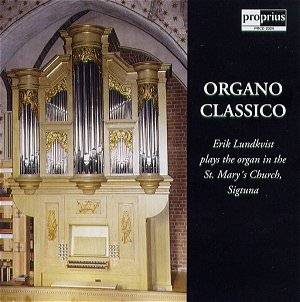This CD, as can be seen, features
a magnificent Swedish instrument with quite a long history. Ludkvist
is a great Swedish organist with a long pedigree. I must admit
however that less than an hour’s worth of music is rather short
measure nowadays and the chosen repertoire is fairly standard.
The CD booklet, nicely translated
from the Swedish, gives us the organ specification. It has just
two manuals, Swell and Great plus a pedal board with seven stops:
two at 16’ and a mixture with three ranks. There is no 32’ stop
but there seems, especially in the Mendelssohn, no reason to regret
that. The photograph shows the twenty-seven available stops.
The history of the instrument
is fascinating. The church dates from 1247/8 and an organ was
in place then. But it was in 1511 that "a good instrument
was built in the church". This was not replaced until 1749.
The present fine façade together with some visible pipes
can be seen from that period. This organ by Olof Hedlund was in
position in a balcony until 1905 but was replaced again in 1924
when it was given twenty-three stops. In 1971 it was refurbished,
restoring the 1749 façade and adding the present 16’ stops.
Amazingly a new organ was commissioned in 1998 from Gronlunds
Orgelbyggeri. This was inaugurated in 2000 and this disc is the
first recording featuring the instrument.
It was a fine idea to ask Erik
Ludkvist to undertake the recording. He has for many years been
a resident organist in Stockholm and has played all over the world.
He is also particularly interested in promoting contemporary Swedish
composers as well as playing the tried and tested repertoire.
This CD includes Bach and Böhm,
composers whose music must have been played on the 1749 organ
and by Torsten Nilsson, a very well-known figure in Swedish church
music and a fine organist himself. His piece is a rare Organ Mass
(without a Credo) in which, at times, i.e., the Hosanna and the
Agnus, it is almost possible to sing the words to the music. The
mysterious opening Kyrie begins with a beautiful "trembling
4-foot flute that is thrice interleaved with the prayer, Kyrie
Eleison, Christe Eleison, Kyrie Eleison" (CD booklet notes
by Erik Ludkvist himself). Both the Gloria and the Sanctus however
are strong and thrilling especially the former which includes
huge cluster dissonances created by the arm or wrist across the
keyboard. This work is central to the recital.
The other items include a rather
dull, in my view, Partita by Georg Böhm, a teacher of, and
an influence upon, the great Bach. In ‘Freu dich sehr, o meine
Seele’ one feels that the harpsichord is not far away. It is an
excellent idea that each of the eleven variations is given a separate
track. The penultimate variation uses the mellifluous 8-foot principal
stop mentioned above from the 1749 Hedlund Organ.
The Bach Choral Prelude is tastefully
played. The Prelude and Fugue which opens the disc and the famous
Mendelssohn Sonata which closes it are classical in execution
and obviously played by a man who knows the music inside out.
Verdict: Good performances and
a fine recording make this a very tempting disc.
Gary Higginson
